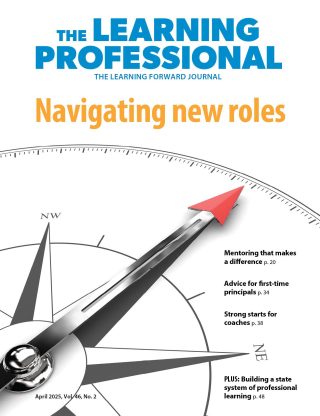IDEAS
Reframing observation
Create a culture of learning with teacher evaluation
By Rachael Gabriel
August 2018
Vol. 39 No. 4
Read the remaining content with membership access. Join or log in below to continue.
Sed ut perspiciatis unde omnis iste natus error sit voluptatem accusantium doloremque laudantium, totam rem aperiam, eaque ipsa quae ab illo inventore veritatis et quasi architecto beatae vitae dicta sunt explicabo. Nemo enim ipsam voluptatem quia voluptas sit aspernatur aut odit aut fugit, sed quia consequuntur magni dolores eos qui ratione voluptatem sequi nesciunt. Neque porro quisquam est, qui dolorem ipsum quia dolor sit amet, consectetur, adipisci velit, sed quia non numquam eius modi tempora incidunt ut labore et dolore magnam aliquam quaerat voluptatem.
References
Gabriel, R. (2015). Not whether, but how: Asking the right questions in teacher performance assessment. Language Arts, 93(2), 120-127.
Gabriel, R. & Woulfin, S. (2017). Making teacher evaluation work: A guide for literacy teachers and leaders. Portsmouth, NH: Heineman.
Gabriel, R. & Woulfin, S. (2015). Evaluating the structure and content of observation instruments. In R. Gabriel & R. Allington (Eds.), Evaluating literacy instruction: Principles and promising practices. New York, NY: Routledge.
Grossman, P., Cohen, J., & Brown, L. (2014). Understanding instructional quality in English language arts: Variations in PLATO scores by content and context. In T. Kane, K. Kerr, & R. Pianta (Eds.), Designing teacher evaluation systems: New guidance from the Measures of Effective Teaching Project (pp. 303-331). San Francisco, CA: Jossey-Bass.
Measures of Effective Teaching Project. (2012). Gathering feedback for teaching combining high-quality observations with student surveys and achievement gains. Seattle, WA: Bill & Melinda Gates Foundation.
Recent Issues
LEARNING DESIGNS
February 2025
How we learn influences what we learn. This issue shares essential...
BUILDING BRIDGES
December 2024
Students benefit when educators bridge the continuum of professional...
CURRICULUM-BASED PROFESSIONAL LEARNING
October 2024
High-quality curriculum requires skilled educators to put it into...
LEARNING TO PIVOT
August 2024
Sometimes new information and situations call for major change. This issue...












